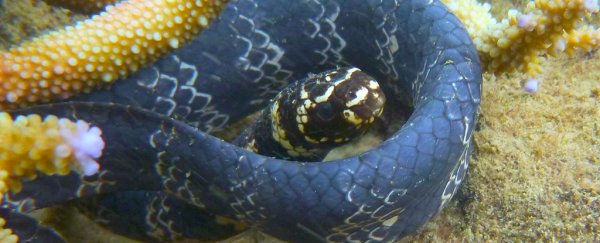Mining waste is having a rather peculiar effect on the evolution of a species of sea snake, which appears to be coping with an increase in heavy metals in their environment by developing a darker skin.
As the first example of industrial melanism found in a marine animal, the turtle-headed sea snake (Emydocephalus annulatus) joins a list of creatures that have adapted to pollution by pumping out more dark pigments.
A small team of international researchers noticed the usually black-and-white striped sea snakes were virtually completely black around certain sites along the coast of the Pacific island of New Caledonia, and questioned whether pollutants in the water might be to blame.
Several years ago another team of researchers hypothesised that Parisian pigeons dealt with the increased concentration of zinc and lead in their blood by producing more of the dark pigment melanin, a protein that binds to the metals.
While the idea isn't without its critics, Claire Goiran from Labex Corail & Université de la Nouvelle-Calédonie was inspired by the possibility, and wondered if it could explain the turtle-headed sea snake's diversity.
Together with renowned cane-toad expert Rick Shine from the University of Sydney and Paco Bustamante from the Université de La Rochelle, Goiran analysed 1,400 discarded snake skins collected from Australia's east coast and New Caledonia over the past 13 years.
Measurements of their trace elements back up their suspicions – darker skins contained significantly higher levels of chemicals such as zinc, manganese, arsenic, nickel, and cobalt.
The trace chemicals were also in higher concentrations in skins taken from snakes found near zones impacted by New Caledonia's nickel mining industry and urban run-off, and a remote atoll on Australia's Great Barrier Reef once used to test bombs.
A mark and recapture study in New Caledonia revealed the darker snakes were also found to shed their skins twice as often as their lighter brethren, even though both sloughed their skin in the same seasonal patterns.
The relationship between the metal concentration, colouration, and location might not be proof positive that melanin is being used to keep pollutants in the blood to below toxic levels, but it's definitely a strong wink in that direction.
It's likely that the elevated levels of trace elements are picked up through the snake's diet, which consists of the eggs of fish that breed in the warm waters.
Comparing numbers and survival rates of each population could add more weight to the hypothesis that the colouration is an adaptive measure in response to the pollution.
Producing dark pigments such as melanin costs the body valuable resources, but it provides benefits by blocking UV radiation that could damage DNA, offering added protection against infectious agents such as yeast, absorbing heat to stay warmer, and colouring the skin to match surroundings.
The case-study of the peppered moth (Biston betularia) is a favourite among high school biology textbooks as an example of industrial melanism and its role in natural selection.
In that case, birds picking the more visible light-coloured moths from a soot-stained background were responsible for dark colourations becoming more abundant in the moth population.
"The animals I study continue to astonish me," says Shine.
"I think it's remarkable to find industrial melanism in organisms as different as moths and seasnakes!"
It's also possible that there are multiple advantages to the colour change, with removal of trace metals just one of them. Evolution isn't exactly picky about which jobs an adaptation serves, so long as it's worth the cost.
If the darkened skins are a response to pollution levels, it would mean a rather rapid evolutionary shift, not to mention a stark reminder of how human activity has far reaching implications.
This research was published in Current Biology.
